
Hello everyone!
Today, I’m excited to take you on a journey to the oldest house in Phuket—a place where history lives and breathes. Despite being 119 years old, this remarkable house, known as Baan Chinpracha, still stands in its original condition, with a structure as strong as ever. “Baan” means “house” in Thai, and Baan Chinpracha is an exquisite example of Sino-Portuguese architecture (often called Chinese Baroque), a style unique to Phuket. Built in 1903 by Phra Pitak Chinpracha as a gift for his eldest son, this home has witnessed generations of history.
The house’s current owner, Khun Chin Sathan Phithak, still resides here, making Baan Chinpracha a true living museum. Visitors can explore the beautifully preserved first floor, where every room and corner seems to tell a story. The house is located right in Phuket Old Town, in Tambon Talat Nuea, Mueang Phuket District, making it easy to find for those exploring this historic area.
To visit Baan Chinpracha, there is an entrance fee of 100 baht (around $2.63 USD). For those who want an immersive experience, there’s also an option to dress up in traditional “Yaya” costumes for an additional 400 baht (about $10.52 USD), bringing the total to 500 baht ($13.15 USD). It's a wonderful way to step back in time and capture the charm of old Phuket!
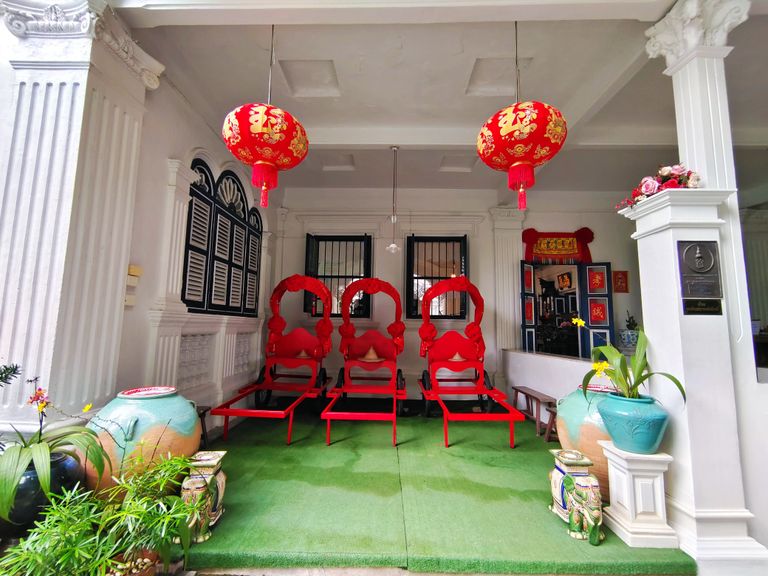
Baan Chinpracha is a two-story, white Sino-Portuguese-style house, adorned with intricate Chinese stucco patterns. Out front, you’ll find a charming red jinrikisha, a traditional hand-pulled cart once used in Phuket wedding ceremonies. It’s a popular spot where tourists can step inside for a unique photo opportunity!
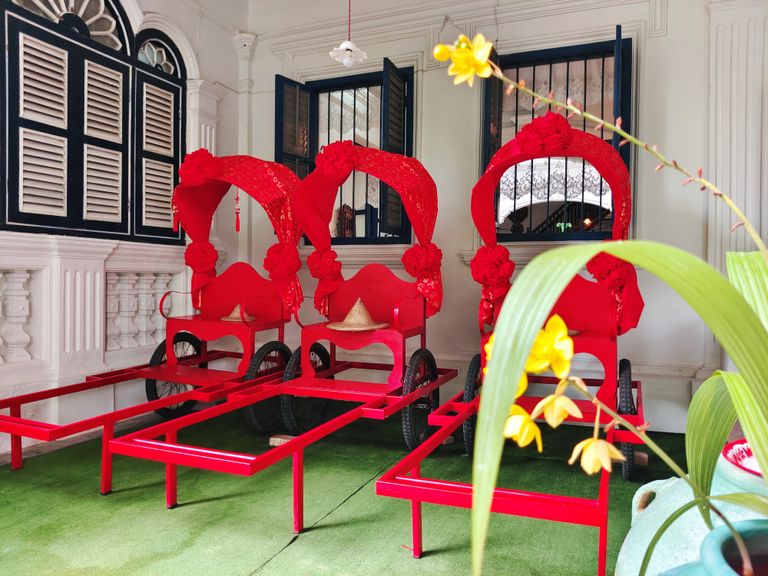
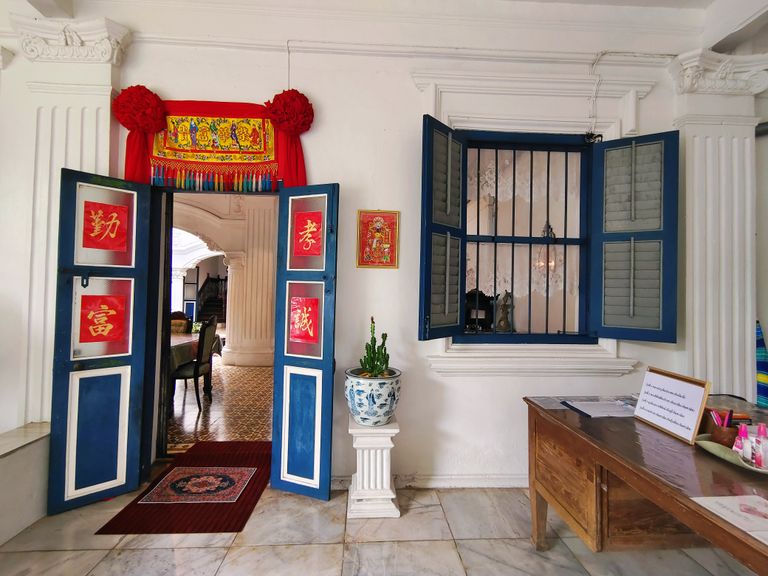
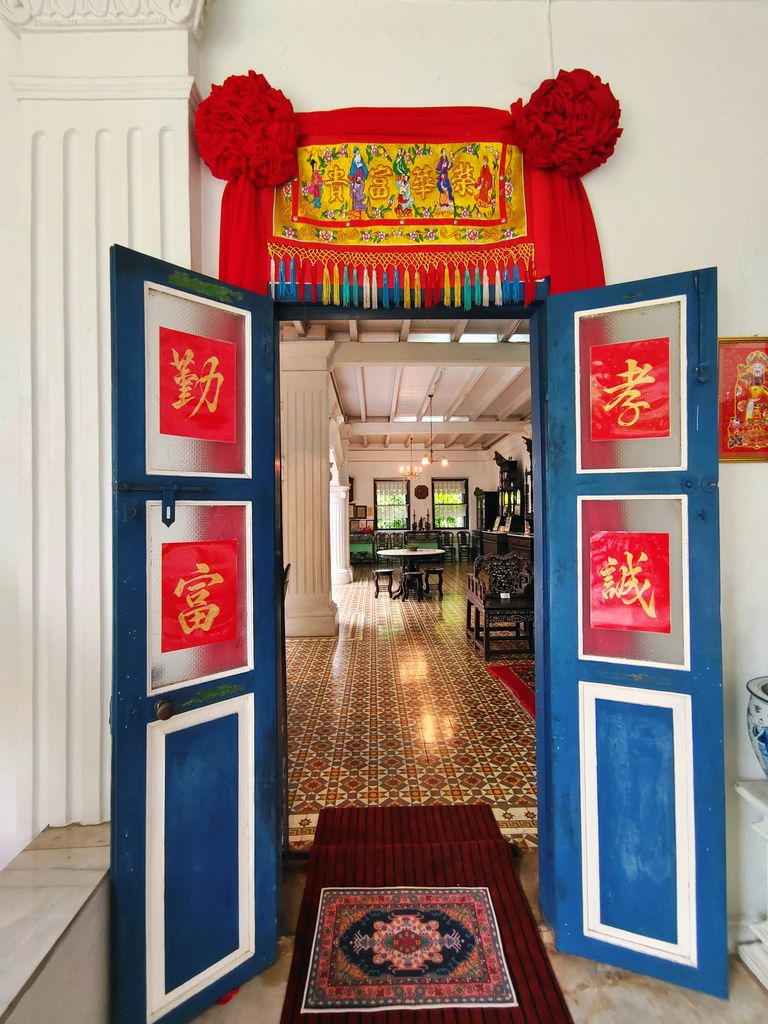
The entrance door is adorned with red Chinese characters—a color symbolizing prosperity. Stepping through this door leads directly into the living room.
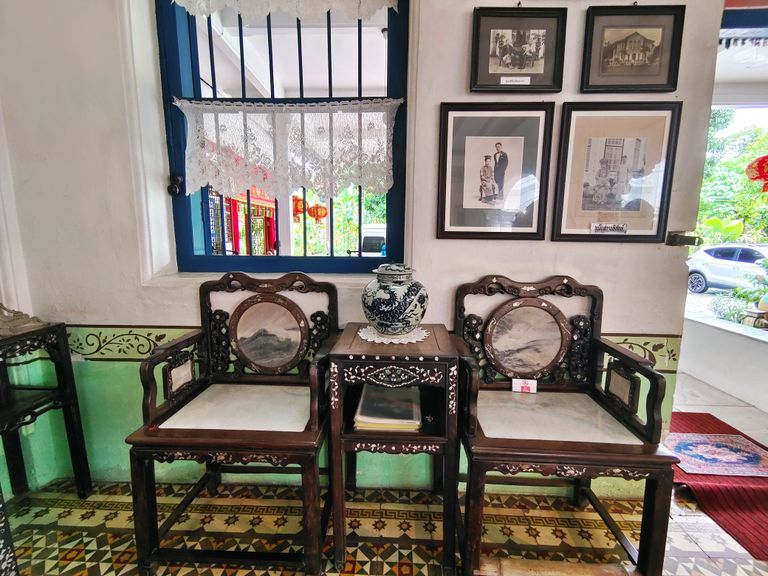
Inside, you’ll find various pieces of antique furniture that have aged gracefully over more than a century. These items were imported from China and Penang, reflecting the rich cultural influences in Phuket during the tin mining era. The current owner, a descendant of Chinese immigrants who came to work in Phuket's tin mines, takes great pride in preserving these beautiful, historic pieces, which add so much character to Baan Chinpracha.

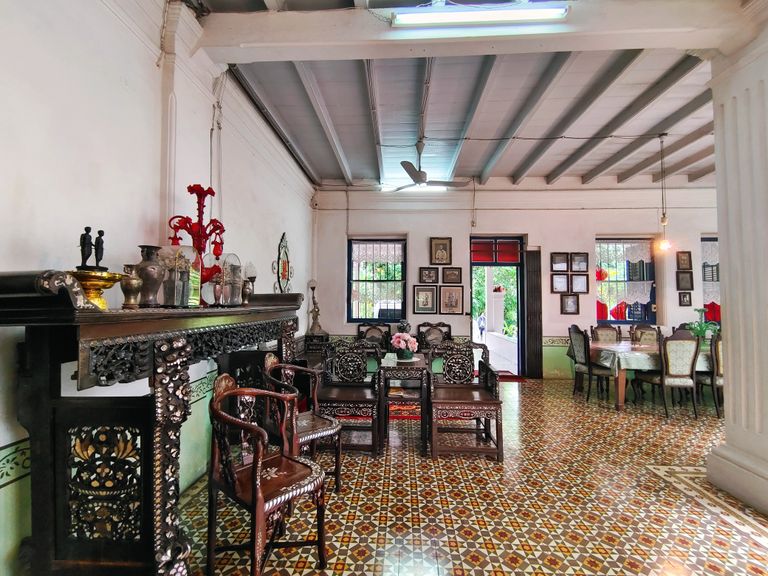
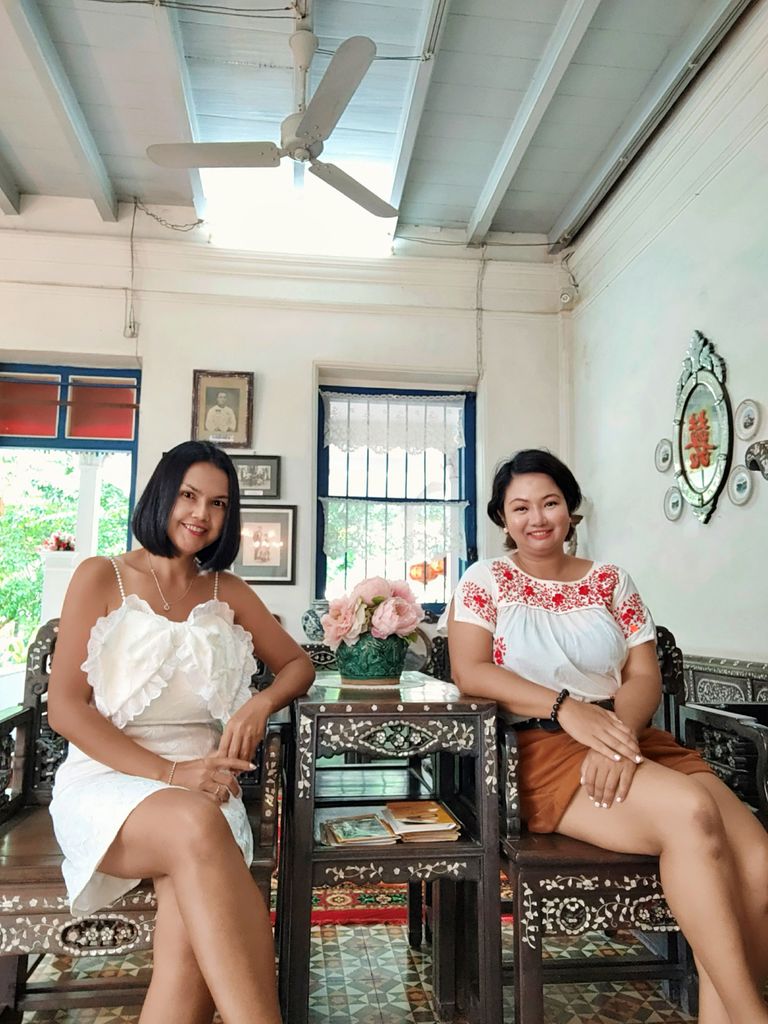
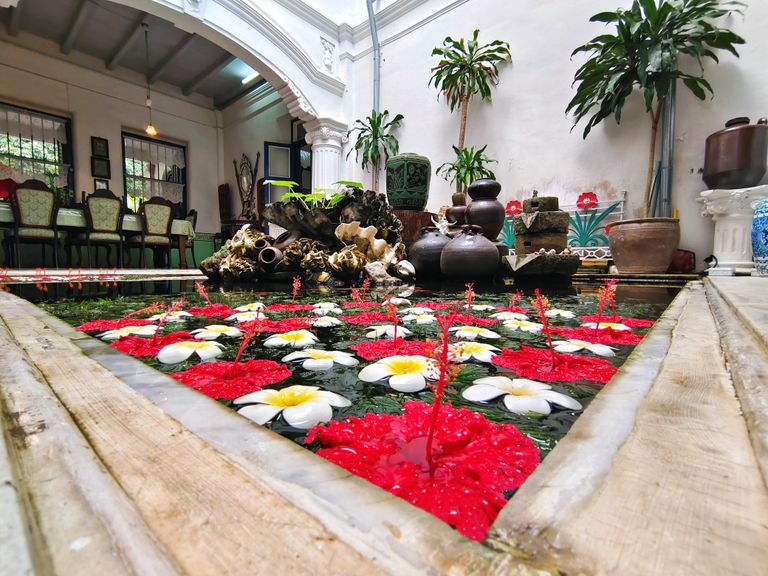
One of the highlights of this Sino-Portuguese-style house is the large air vent located at the center of the home. This unique feature allows for excellent ventilation, keeping the interior cool and bright throughout the day. In this central area, a beautiful koi fish pond has been created, adding not only charm but also aligning with feng shui principles—an ancient Chinese philosophy focused on harmonizing individuals with their surrounding environment. According to feng shui, elements like water and natural light promote balance and positive energy, creating a sense of peace. The koi pond, as a symbol of luck and prosperity, brings a touch of nature into the heart of the house, making it even more inviting and serene.
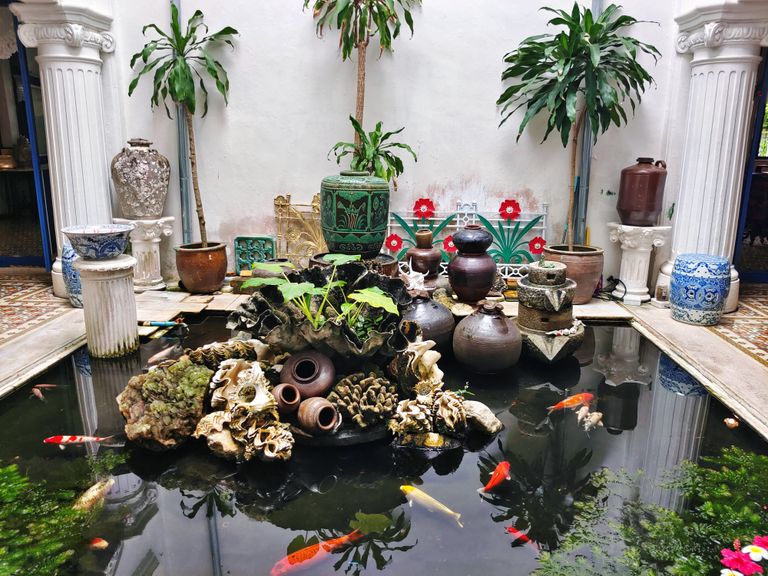
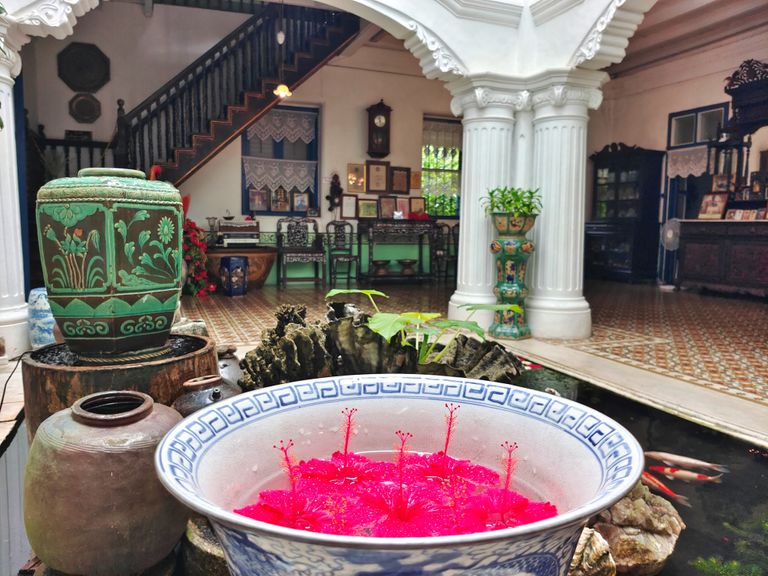
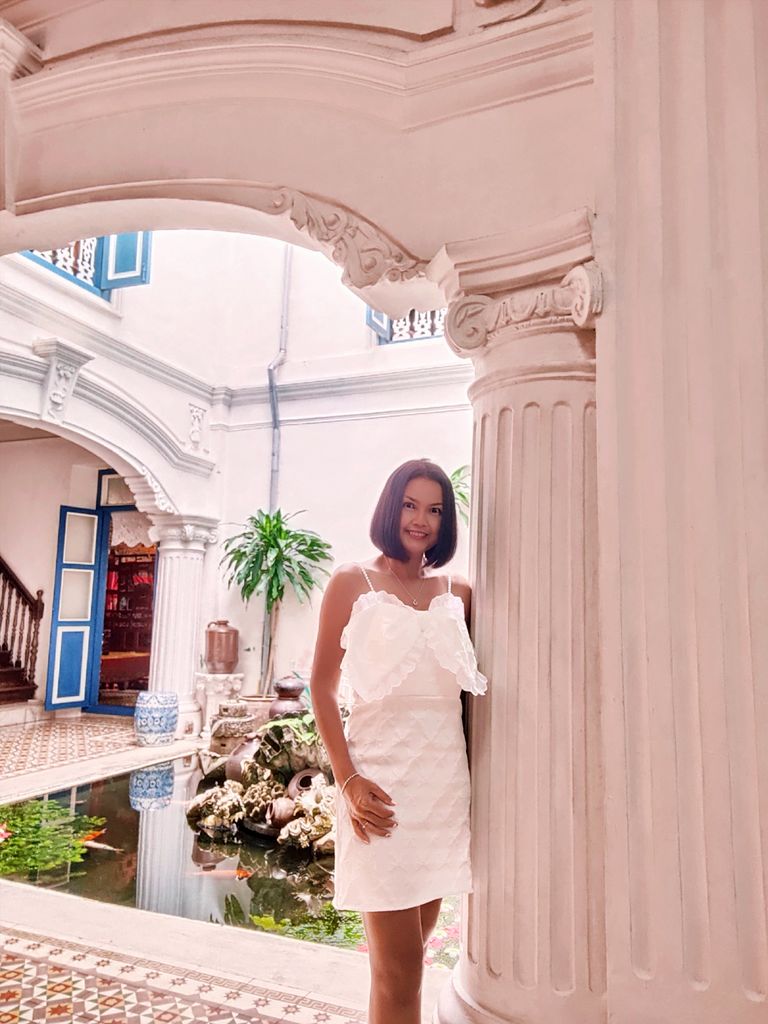
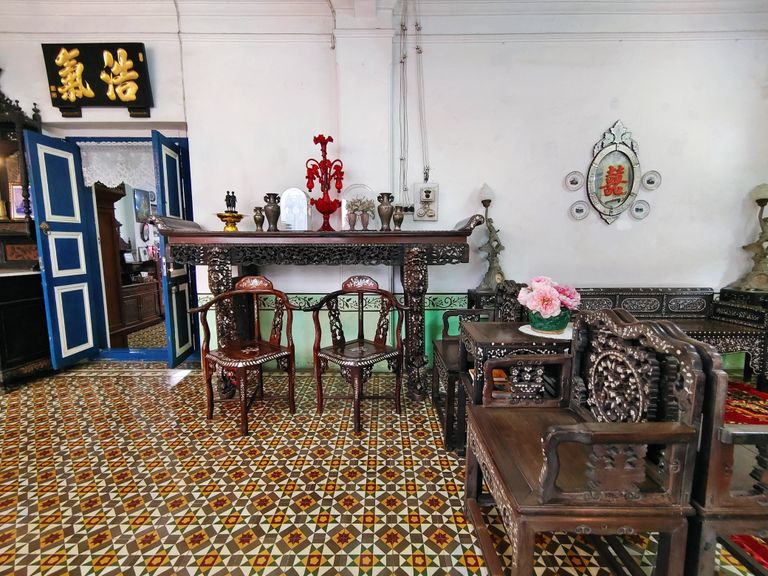

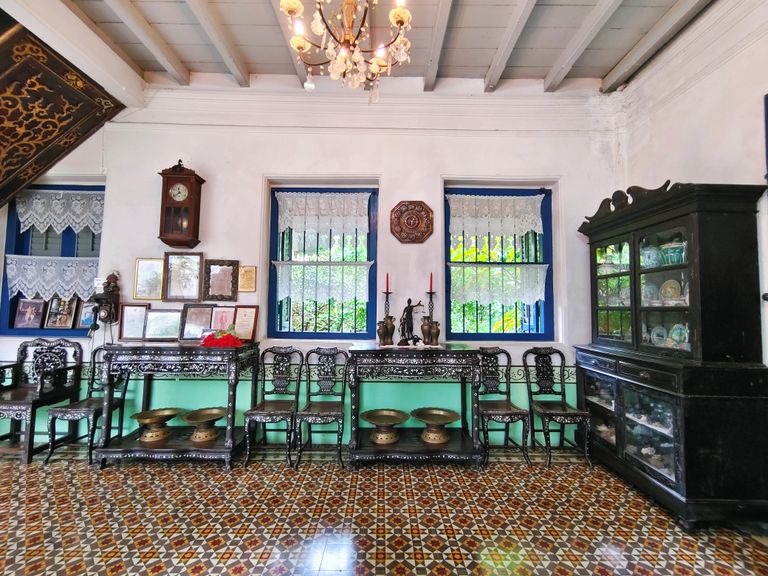
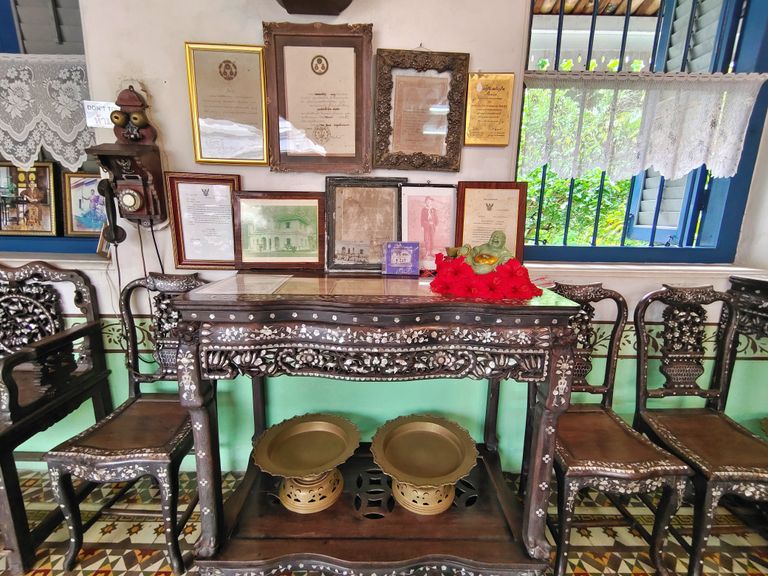
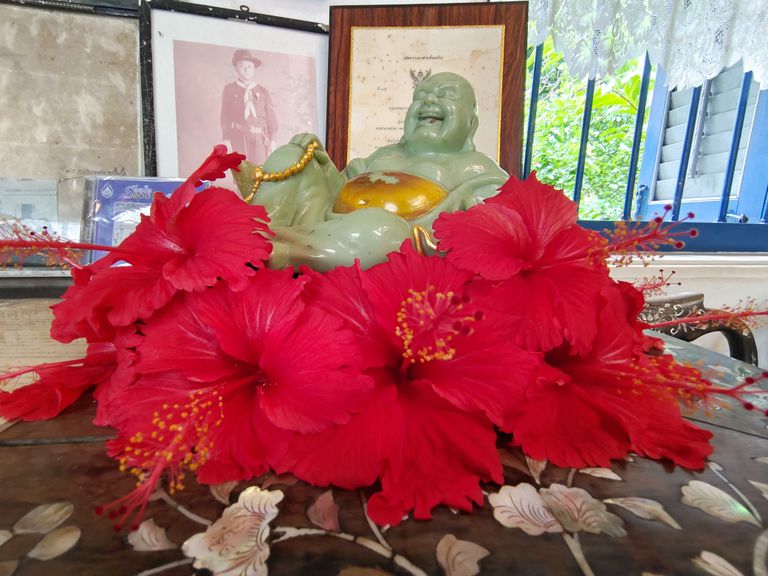
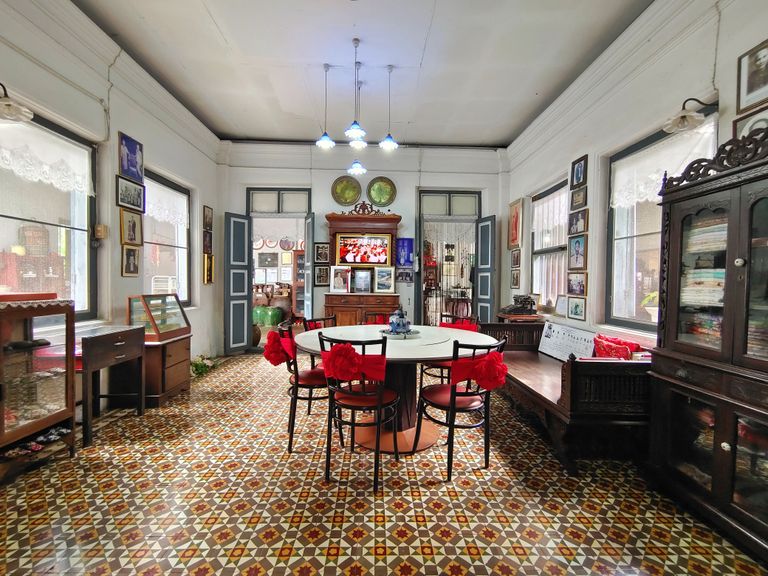
Next to the living room is another room filled with cherished artifacts that hold deep sentimental value. Here, you’ll find an array of historical treasures—from photographs that capture moments of the past to delicate pottery, crockery, and even traditional clothing, shoes, jewelry, and women’s headpieces that resemble elegant crowns.
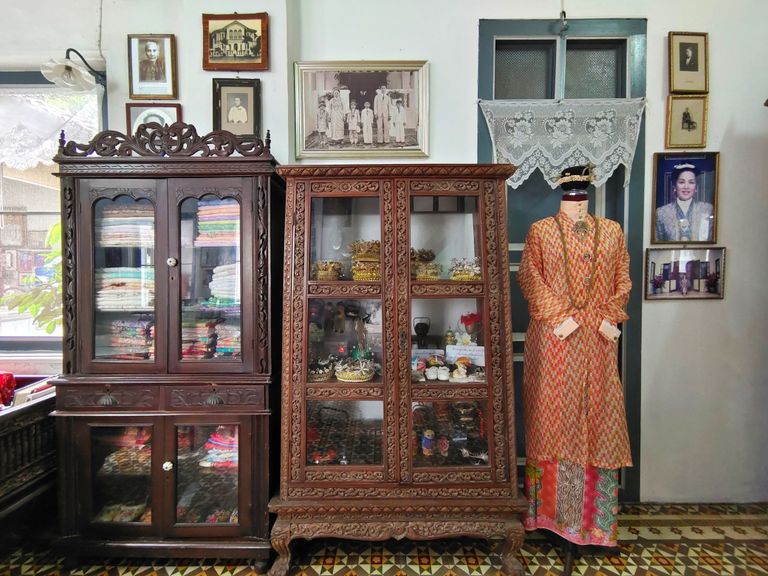
The room also showcases an antique wardrobe alongside a beautifully crafted jewelry cabinet and a traditional Nonya dress—a distinctive piece that reflects the cultural blend of Chinese and Malay heritage.
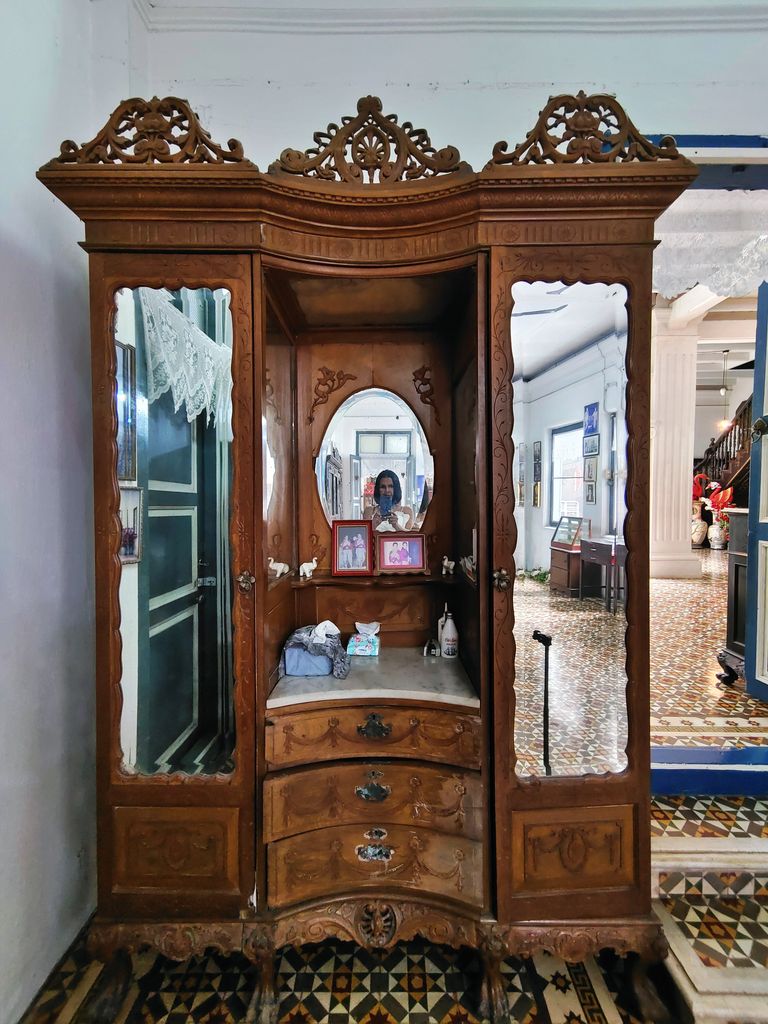
Adding to the charm is a timeless marble vanity table, a perfect reflection of the craftsmanship and elegance that define Baan Chinpracha.
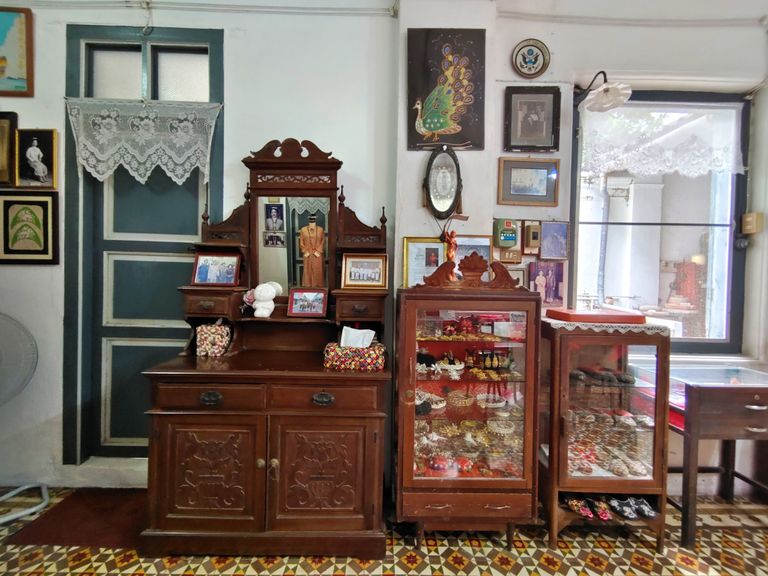
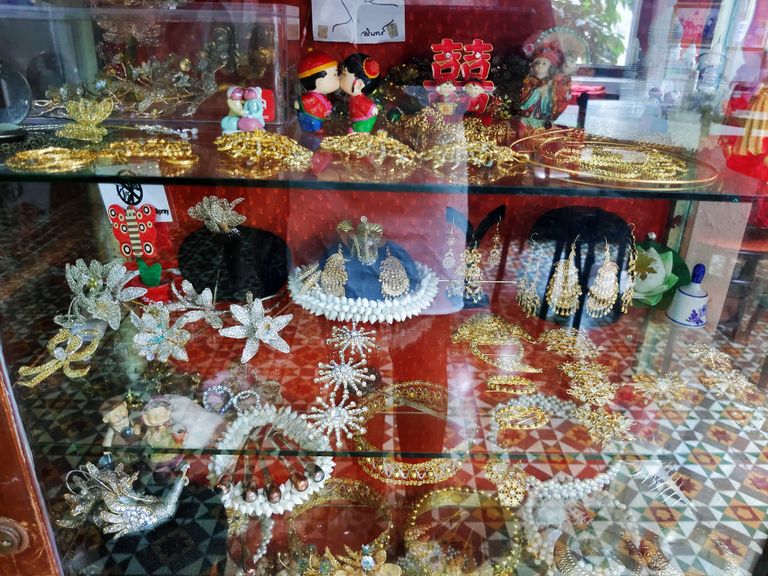
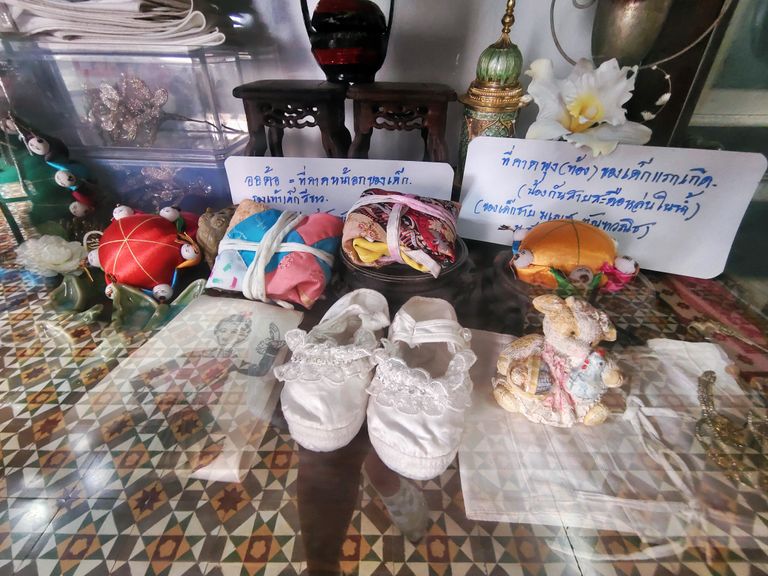

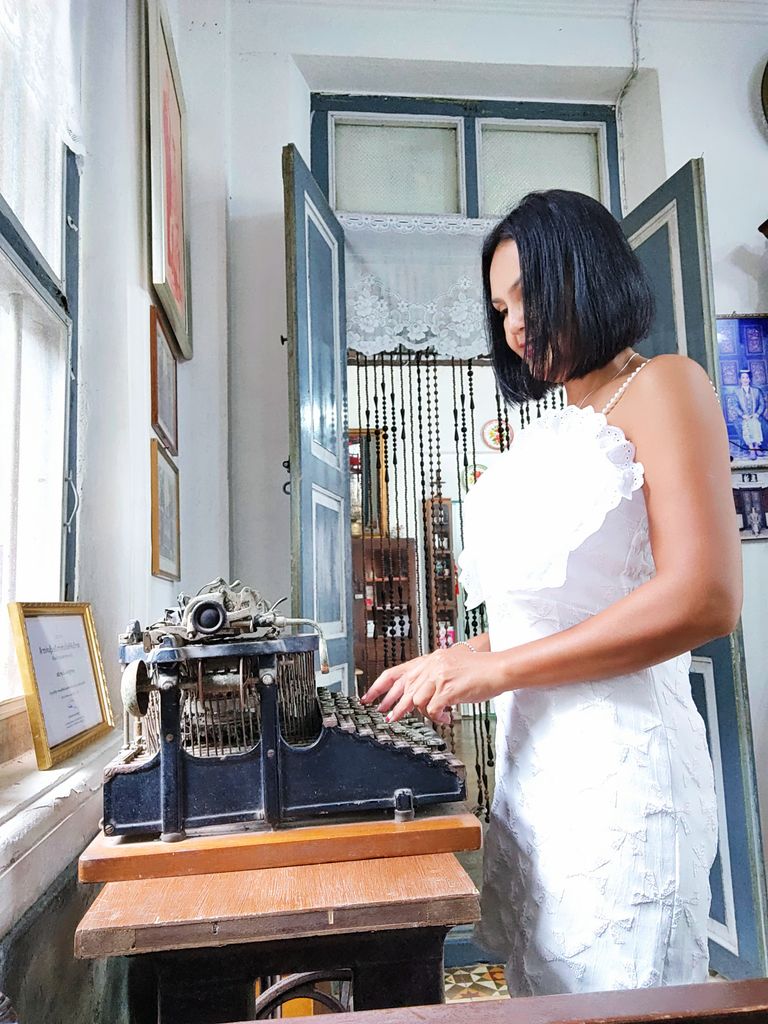
Among the many fascinating artifacts at Baan Chinpracha is an antique typewriter—the iconic Smith Premier No. 5. It instantly took me back to my high school days when I took special classes in typing. Those lessons taught me the art of typing quickly and accurately, skills that have served me well over the years. Seeing this vintage typewriter reminded me of the pride I felt in mastering the keyboard, and I’m so glad I decided to study typing back then.
Next to the typewriter, there’s also an old television, offering a glimpse into the technology and materials that were once part of daily life. Each piece tells its own story, adding to the unique charm of this historic home.
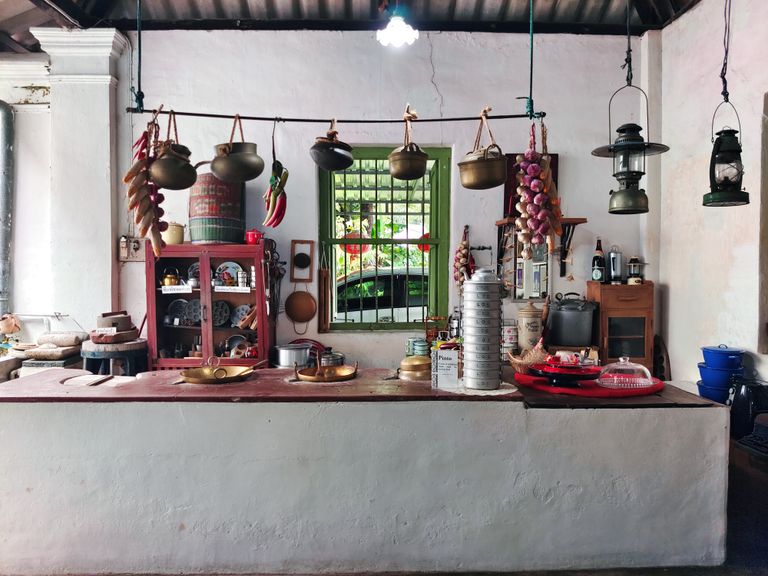
Moving on, we come to the kitchen, a treasure trove of antique utensils and cookware that reflect traditional Thai culinary practices. Here, you’ll find an ancient stove and a brass pan once used for cooking hearty meals, their aged surfaces telling stories of countless family gatherings and celebrations.
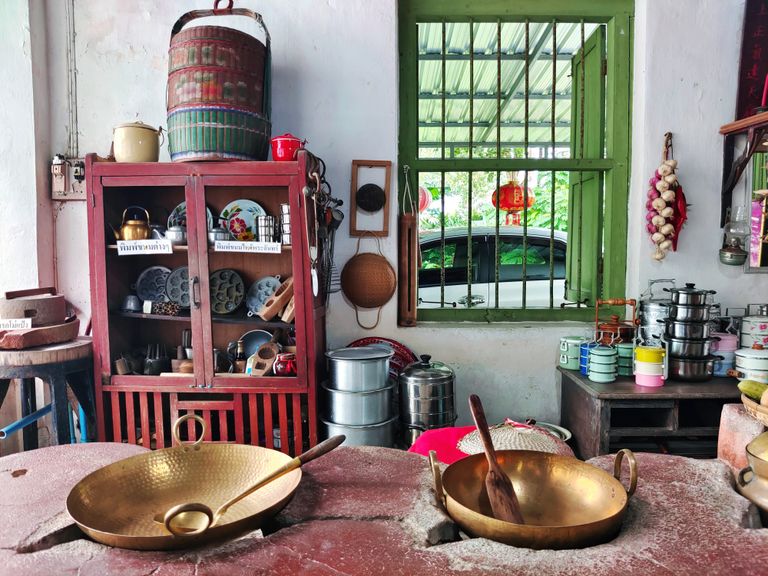
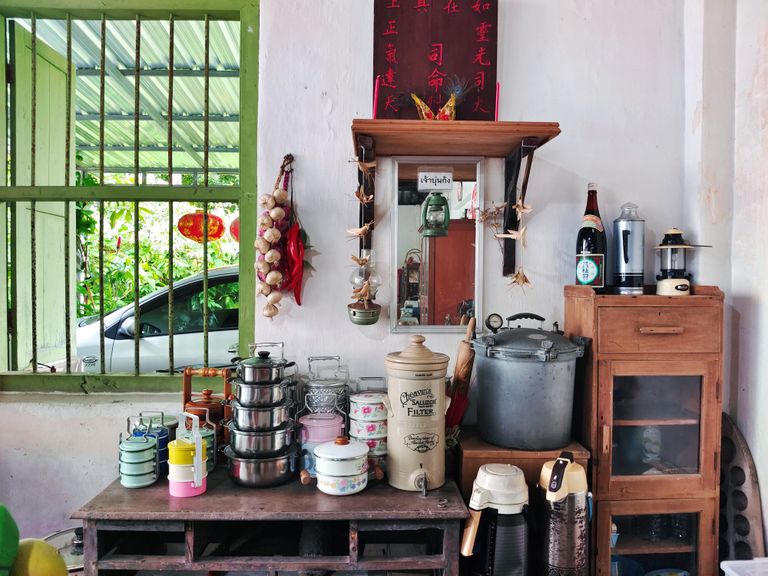
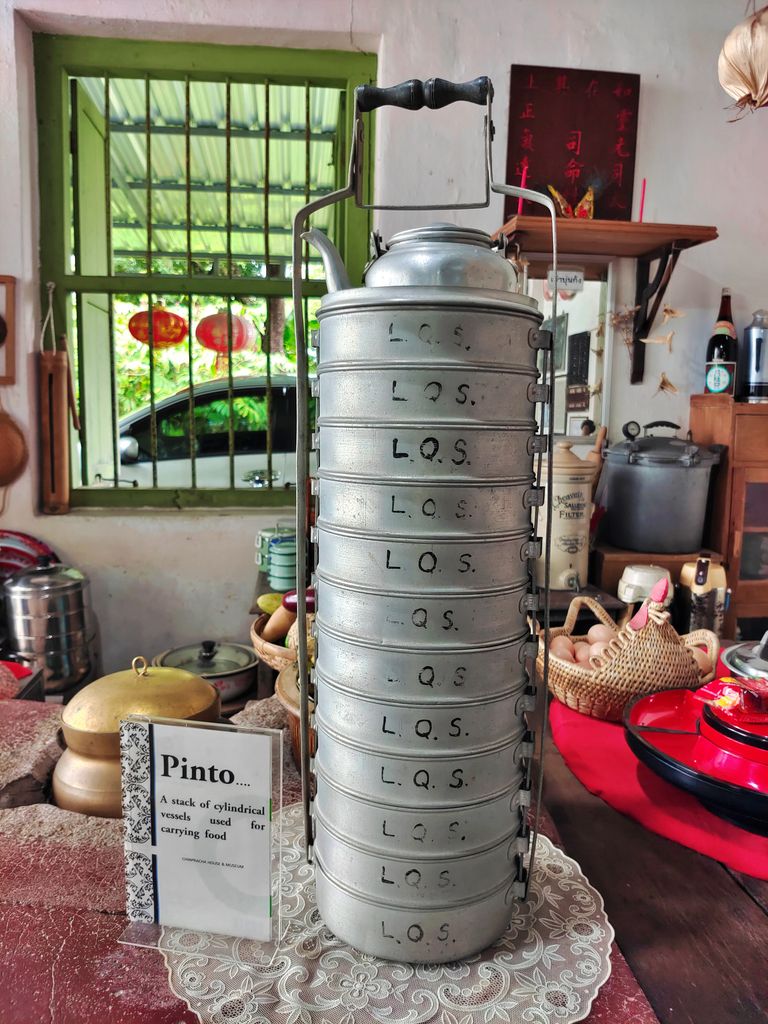
Among the fascinating items is a pinto, a stack of cylindrical containers traditionally used to carry multiple dishes at once. In Thai culture, pinto sets were often used to bring 12 different dishes as offerings to the gods, symbolizing respect and gratitude. The presence of these vintage kitchen items adds a layer of cultural depth to Baan Chinpracha, showcasing how daily life and spirituality were closely intertwined.


Here we have two beautifully crafted antique coal irons, each with unique designs and a charm of its own. Unlike modern irons, these vintage pieces were heated by placing hot coals inside, which warmed the iron plate for pressing clothes. The intricate details on the handles, including a decorative rooster on one of them, showcase the artistry of the time. Once heated, these irons were used to smooth clothes with skill and care—a reminder of the effort people once put into daily tasks. Holding one of these would certainly make you appreciate the conveniences of modern appliances!
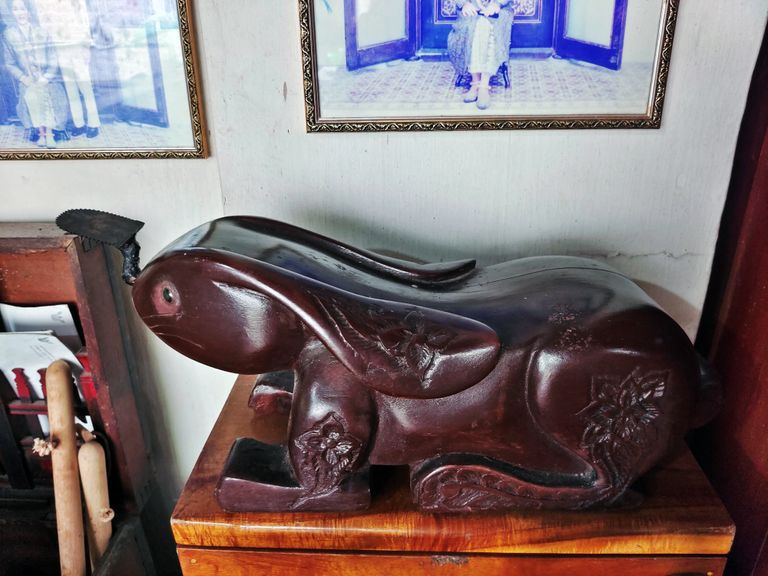
Here we have a charming coconut grater made of wood, uniquely crafted to resemble a rabbit. 🐇 This traditional tool was essential in Thai kitchens for preparing dishes that required fresh coconut milk. The mouth of the "rabbit" features a round metal plate with sharp teeth used for grating. To use it, an old coconut would be peeled, cut in half, and then scraped against the metal plate to produce finely grated coconut. The grated coconut would then be squeezed to extract the rich, creamy milk needed for cooking or making desserts. This delightful tool is a perfect example of how functionality and creativity blend in traditional Thai kitchenware!
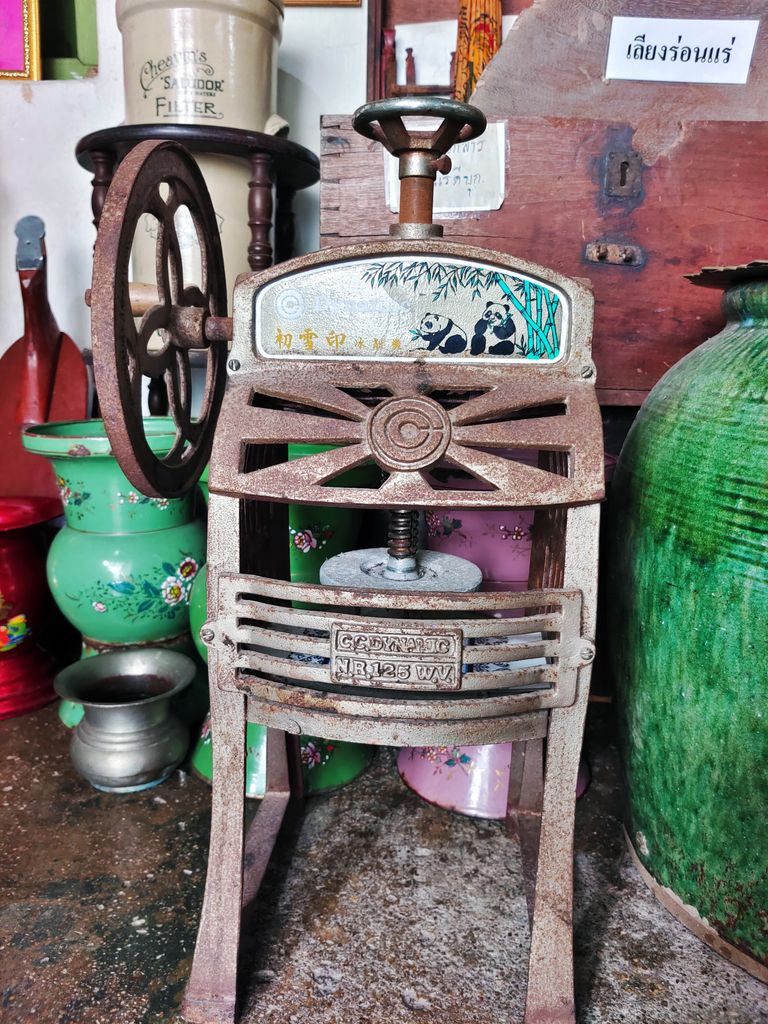
This fascinating piece is an antique ice shaver, a machine once used to create fine ice flakes by hand. To use it, a large ice block would be placed in the middle, and by turning the handle, the machine would scrape the ice, producing delicate ice crystals. This tool was especially handy in the days before electric ice makers, allowing people to enjoy refreshing iced drinks and desserts. The beautiful details on the machine, including the panda illustration, add a touch of charm and reflect the craftsmanship of the time.
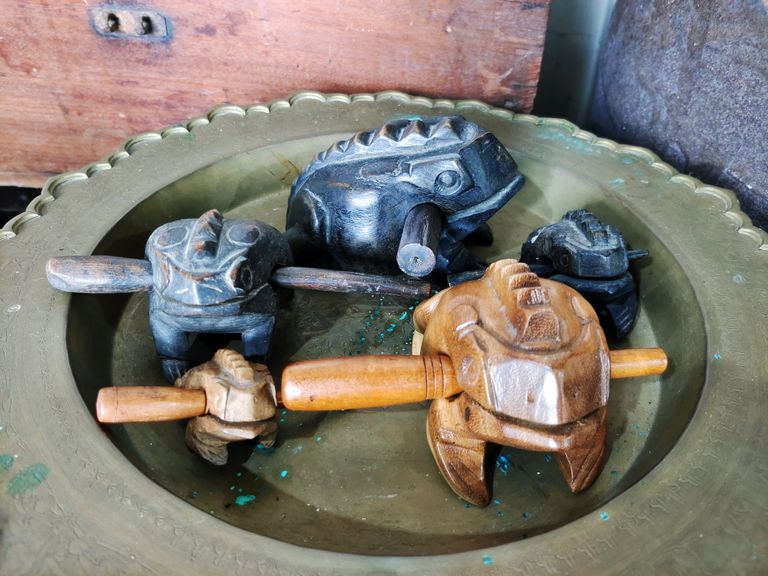
These charming wooden frogs are sounding toys that mimic the croak of a frog when played. 🐸 Crafted from wood, each frog has a textured back and a stick placed in its mouth. By gently dragging the stick along the ridges on the frog’s back, it produces a sound similar to a singing frog. These toys are not only fun for children but also hold a cultural significance in Thai folklore, where they’re often used in traditional music or as souvenirs. The craftsmanship and lifelike sound make these wooden frogs a delightful example of simple, yet ingenious, traditional toys.
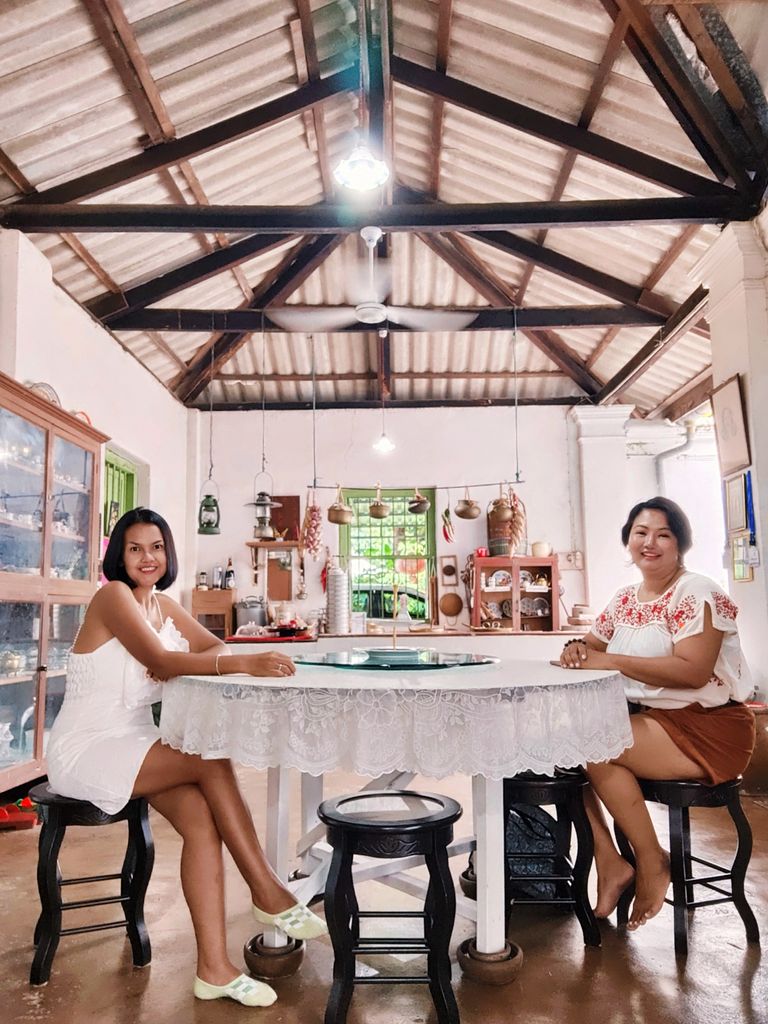
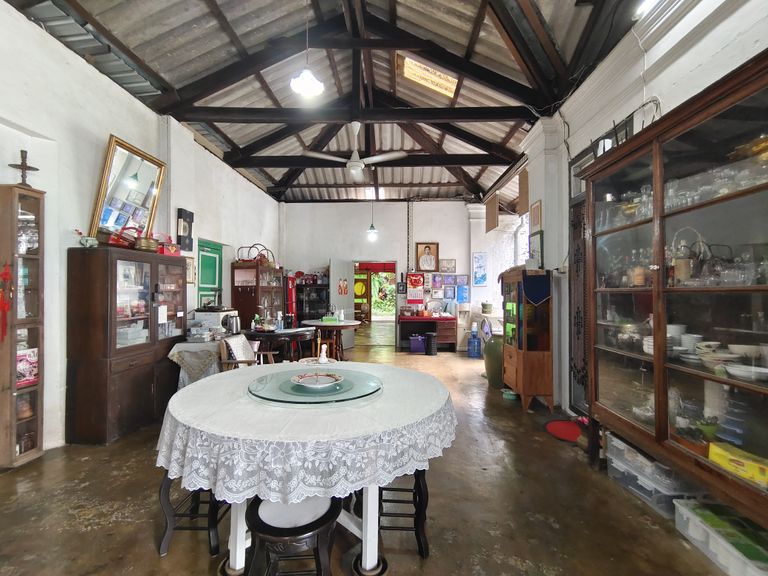
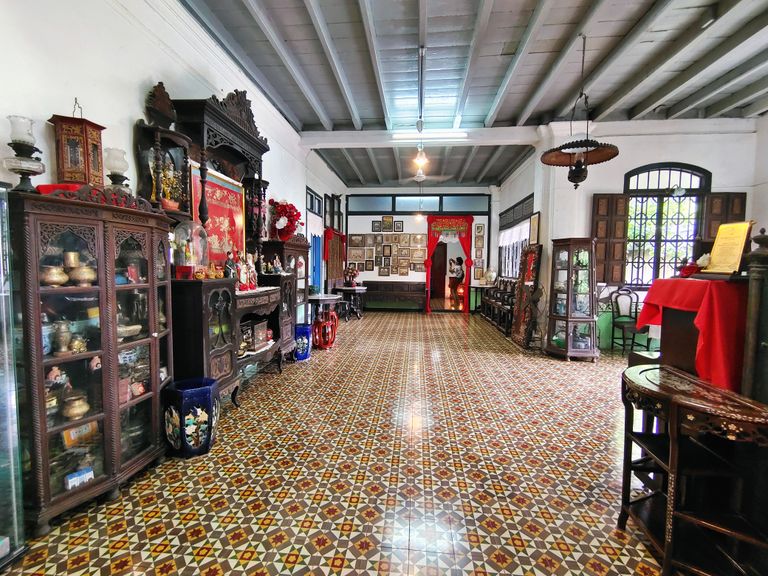
After exploring the kitchen, let’s move on to the final room in the house. This area is divided into two smaller rooms, each with its own purpose and significance. One side serves as a bedroom, filled with antique furnishings and a sense of timeless elegance. The other room is dedicated to honoring the family’s ancestors; it holds photographs of the deceased, carefully preserved as a tribute to those who came before. This space serves as a quiet reflection of the family’s heritage and traditions, reminding visitors of the deep roots that connect each generation.
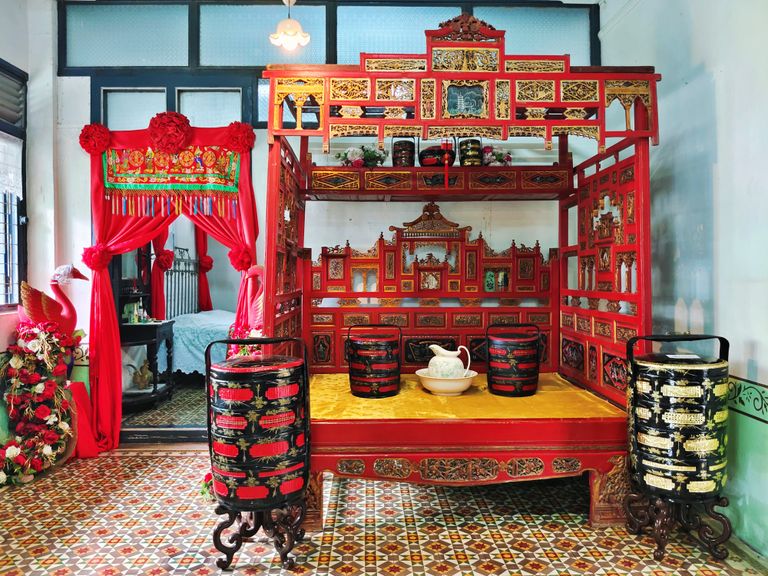
Displayed prominently in front of the bedroom is a magnificent antique red bed, richly adorned with intricate Chinese designs. This ornate bed reflects a time when trade flourished in Phuket, bringing prosperity to many families on the island. With this newfound wealth, Western influences began to seep into the local culture, and Western-style furniture became a symbol of status and success. Over time, traditional Chinese beds like this one were gradually replaced by Western beds as a way for affluent families to showcase their wealth and modern tastes.
The bold red color and elaborate craftsmanship of this bed make it a striking piece, embodying the heritage and cultural pride of the family that once owned it. Surrounded by beautiful lacquered pinto containers and vibrant decorations, this space offers a glimpse into the luxurious yet culturally blended lifestyle of historical Phuket.

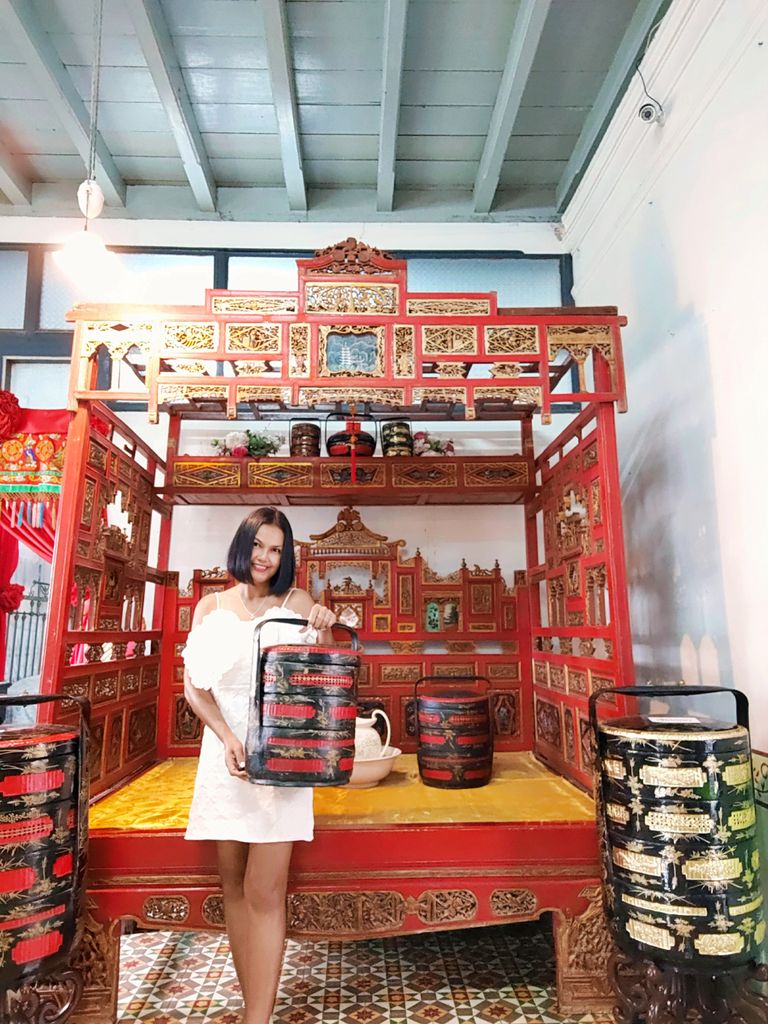

This is the entrance to the bedroom, elegantly framed with vibrant red curtains and adorned with decorative swan figures on each side. The choice of red—a color symbolizing prosperity, happiness, and good fortune in Chinese culture—adds warmth and richness to the space. The swans, often symbols of love and loyalty, lend a touch of grace, making this room feel both welcoming and grand. The combination of intricate details and bold colors reflects the cultural influences that shape the aesthetic of this historic home.

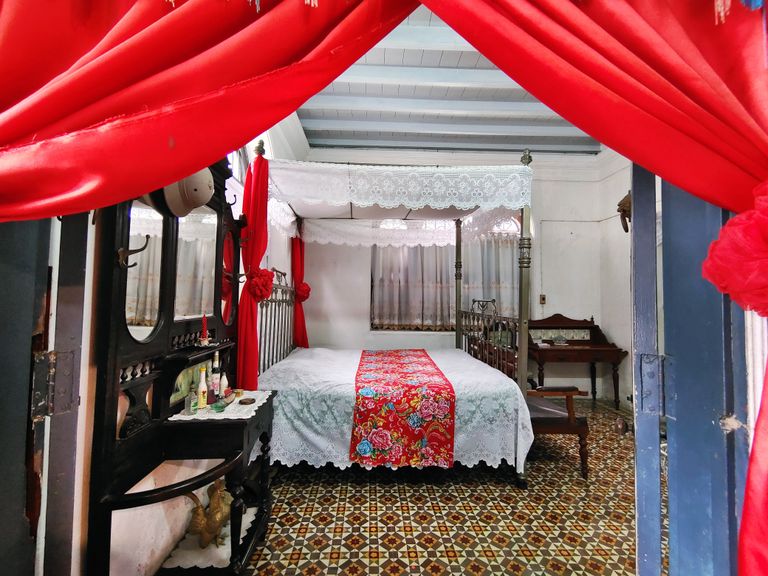
The bedroom features a king-size four-poster bed alongside an elegant dressing table
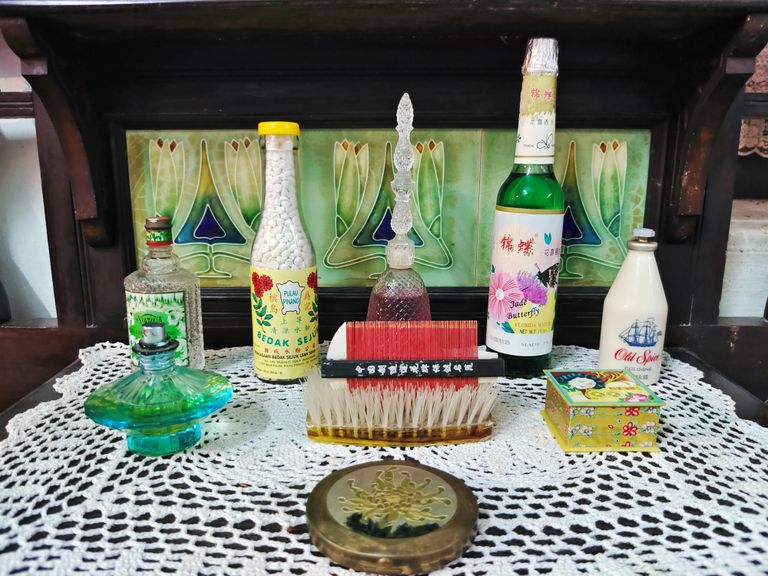
On the dressing table, an assortment of vintage cosmetics, perfumes, and grooming items are displayed, each evoking a sense of timeless elegance. Among them, you’ll find old-fashioned bottles of perfume and cologne, such as the iconic Old Spice and Jade Butterfly Florida Water, along with a delicate glass bottle and a decorative hair comb. There’s even a bottle of Bedak Sejuk from Penang—a traditional cooling powder popular in Southeast Asia. These items provide a glimpse into the personal grooming rituals of a bygone era, reminding us of the charm and sophistication of classic beauty routines.
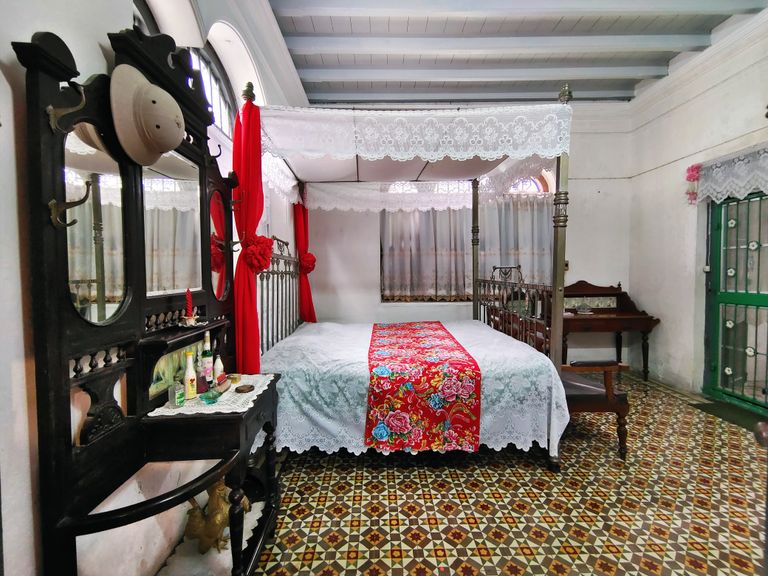
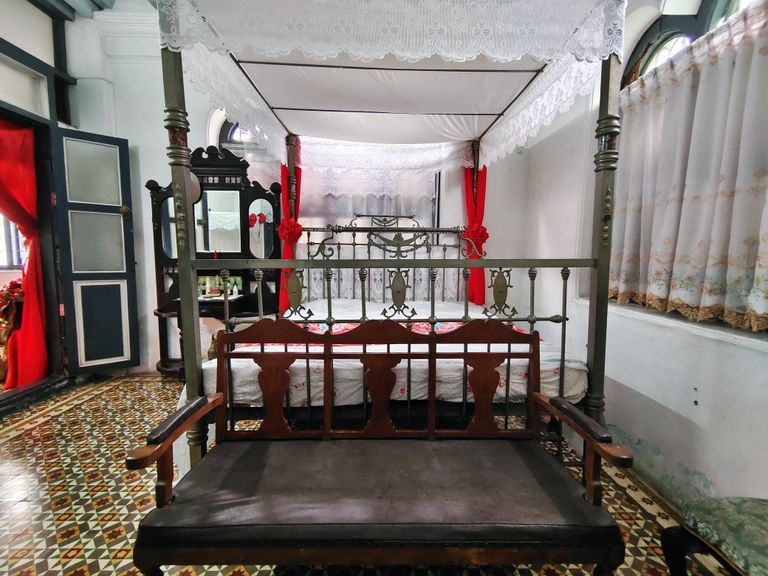
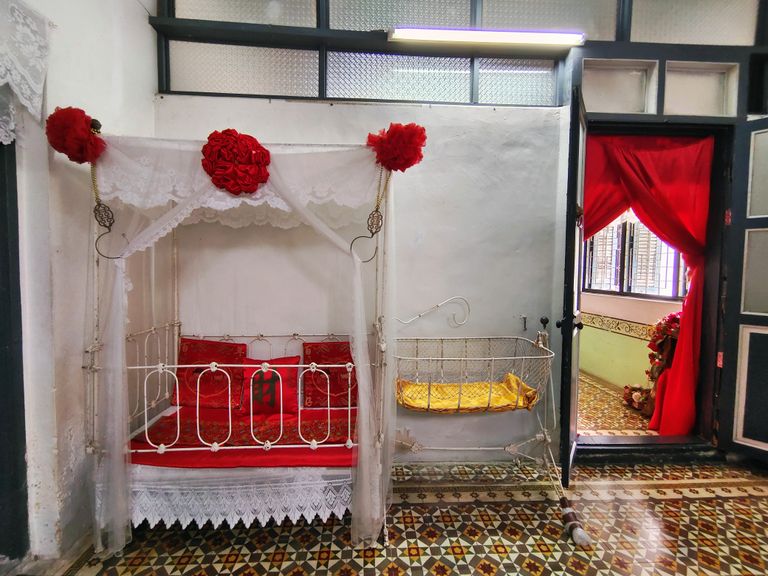


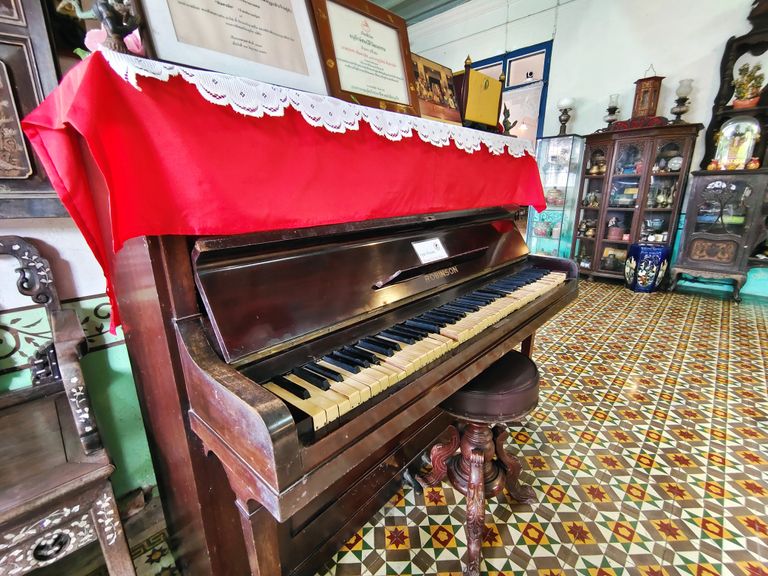
In the central area between the bedroom and the ancestral room, you’ll find a collection of carefully preserved antique items. The centerpiece of this space is an elegant, vintage upright piano, covered with a red cloth that adds a touch of warmth and respect. The piano, bearing the name "Robinson," speaks to a time when live music filled the home, offering entertainment and cultural refinement. Surrounding it are various other utensils and keepsakes, all meticulously displayed. This area reflects the legacy of the family’s tastes and traditions, creating a harmonious blend of art, music, and heritage.
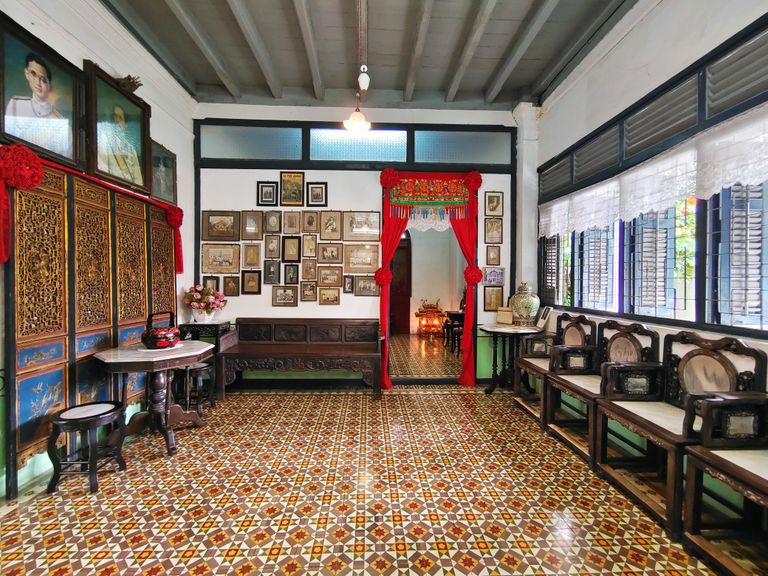

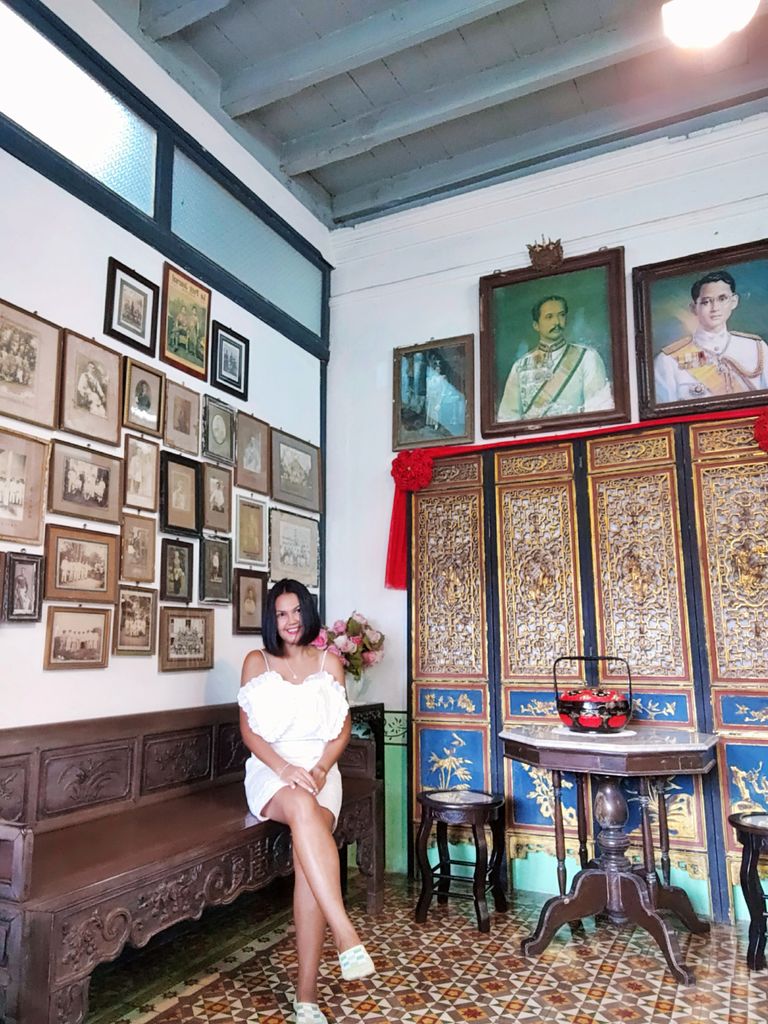
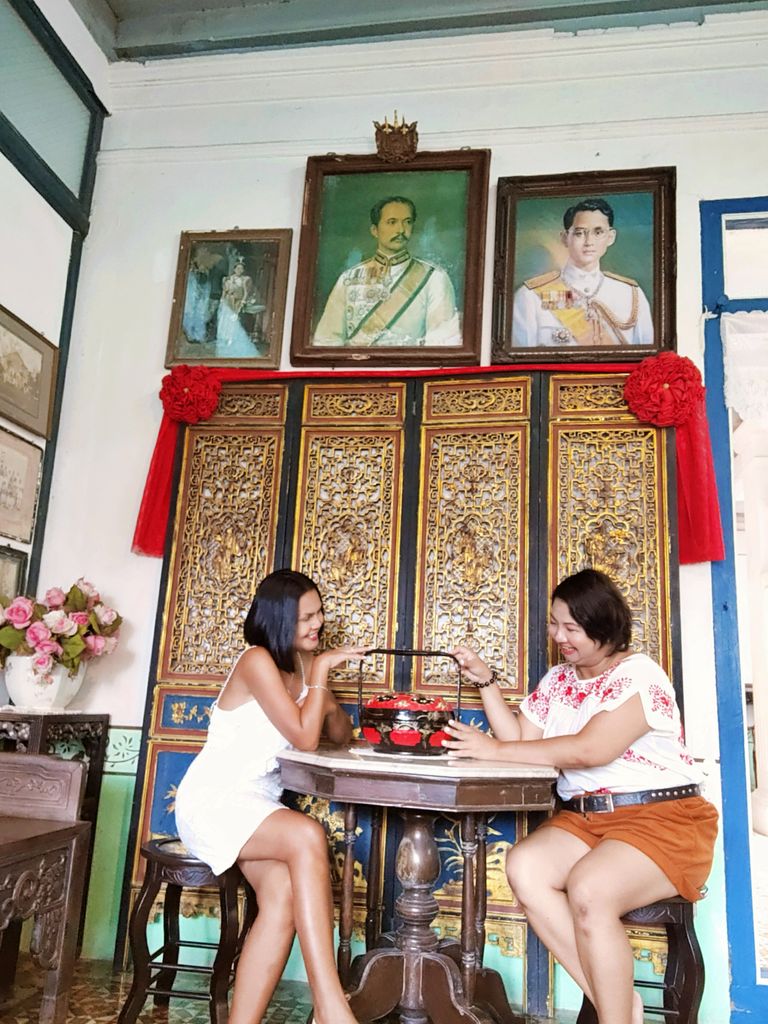
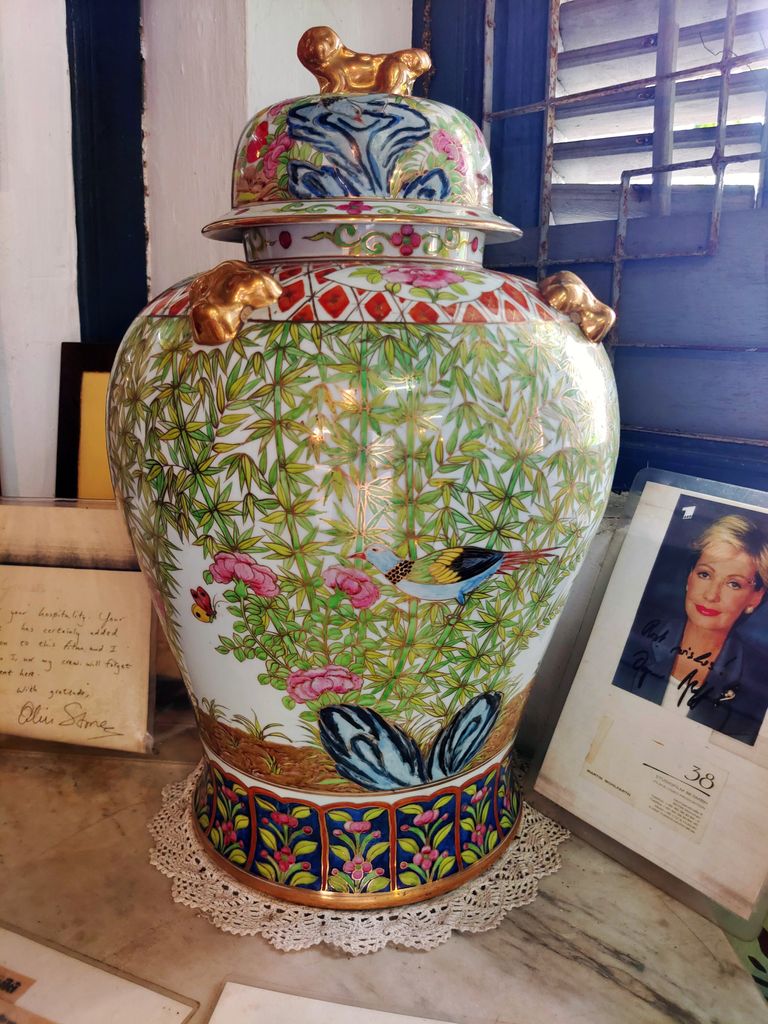
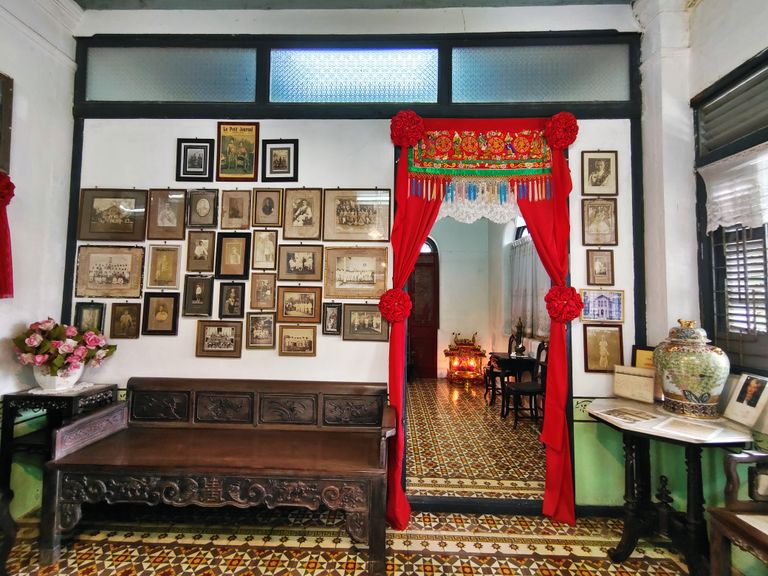
The wall in front of the ancestral room is adorned with a beautiful collection of family photographs spanning multiple generations. Each frame holds a glimpse into the family’s history, capturing the faces and moments of ancestors whose legacy lives on within these walls. The photos, arranged with care and reverence, tell stories of the past and connect the present to those who came before. Framed by vibrant red curtains decorated with traditional patterns, this space feels like a bridge between history and heritage, inviting visitors to reflect on the family’s rich lineage.
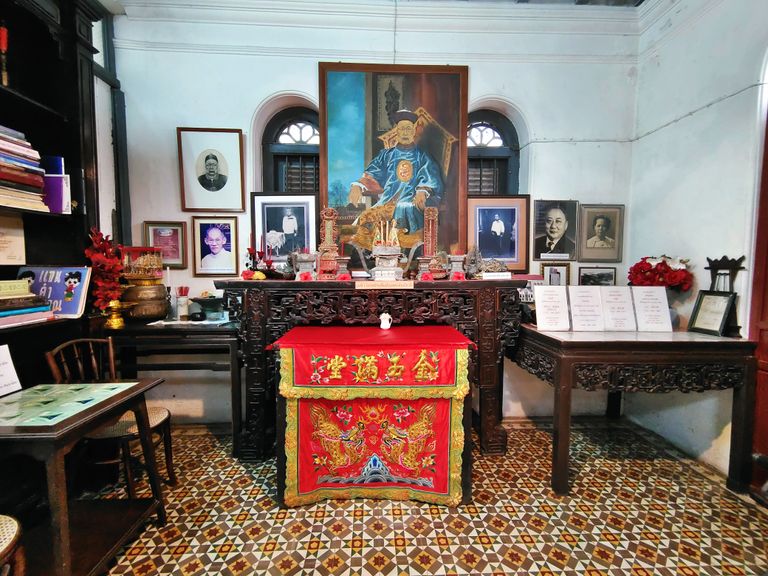
This room is dedicated to honoring the family’s ancestors, with a large portrait of a prominent family member prominently displayed on the central altar table. The portrait, surrounded by ceremonial items and decorated with intricate red fabric, exudes a sense of reverence and respect. On either side of the altar, additional photographs of ancestors are arranged, offering a glimpse into the family’s legacy.
This room also features a traditional table and chairs for quiet reflection, as well as shelves filled with old books, including a biography of the family’s ancestors. Each book and object holds pieces of family history, inviting visitors to connect with the past and learn about the lives of those who helped shape the family’s heritage. This sacred space serves as a lasting tribute to the family’s roots, blending beauty, culture, and remembrance.
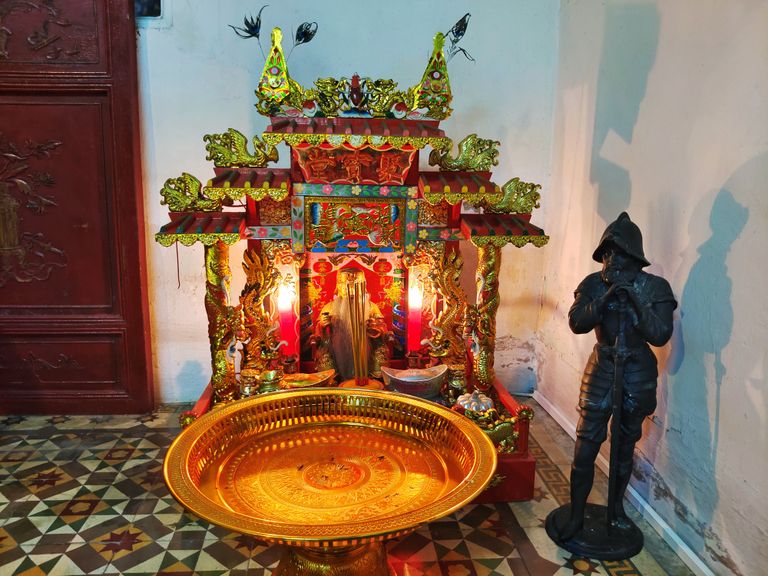
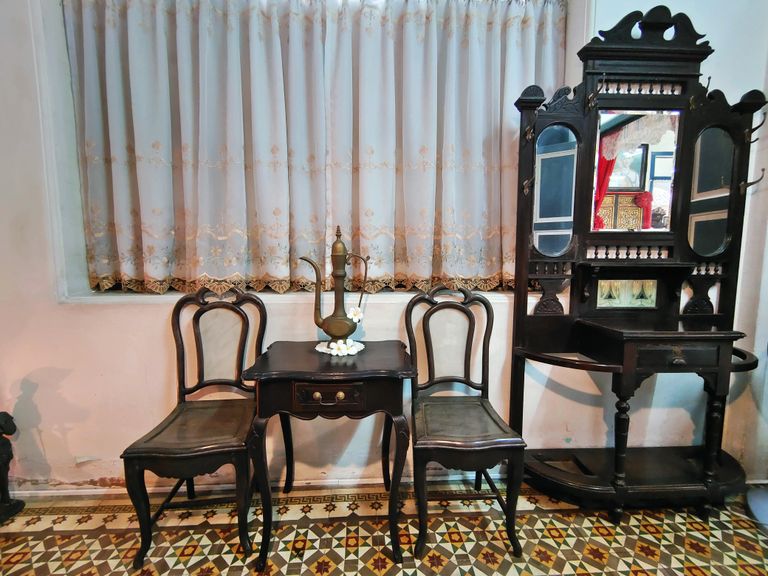
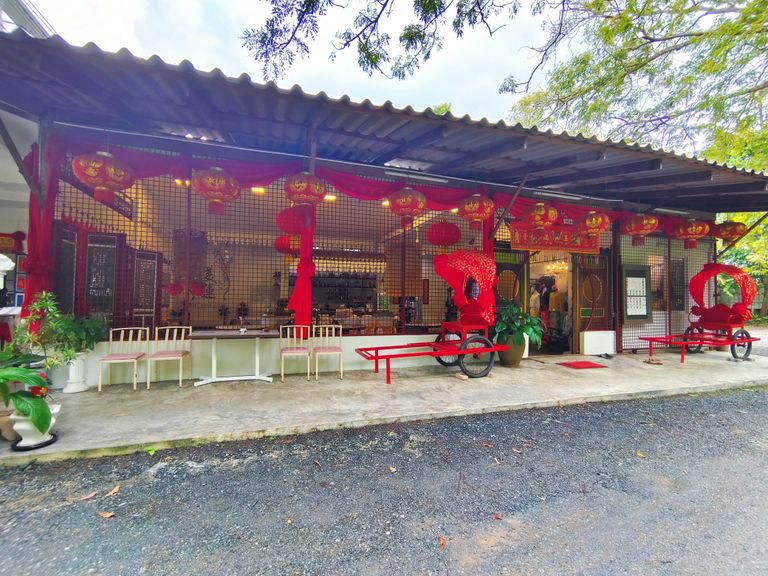
After exploring the house, we stepped outside to find a charming rental area where visitors can dress up in traditional Phuket attire for a memorable photo experience, the price is 400 baht (13.15$). This area, adorned with bright red lanterns and decorative elements, reflects the vibrant colors of local culture. Nearby, there’s a small café where tourists can relax and enjoy a variety of refreshing beverages. This spot provides the perfect end to the tour, offering a blend of tradition, relaxation, and the chance to take a piece of Phuket’s cultural heritage with you in a photograph.


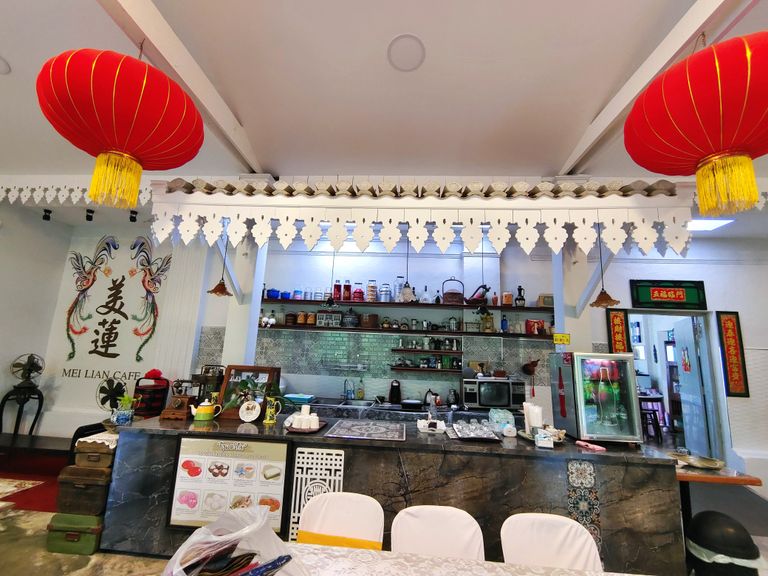
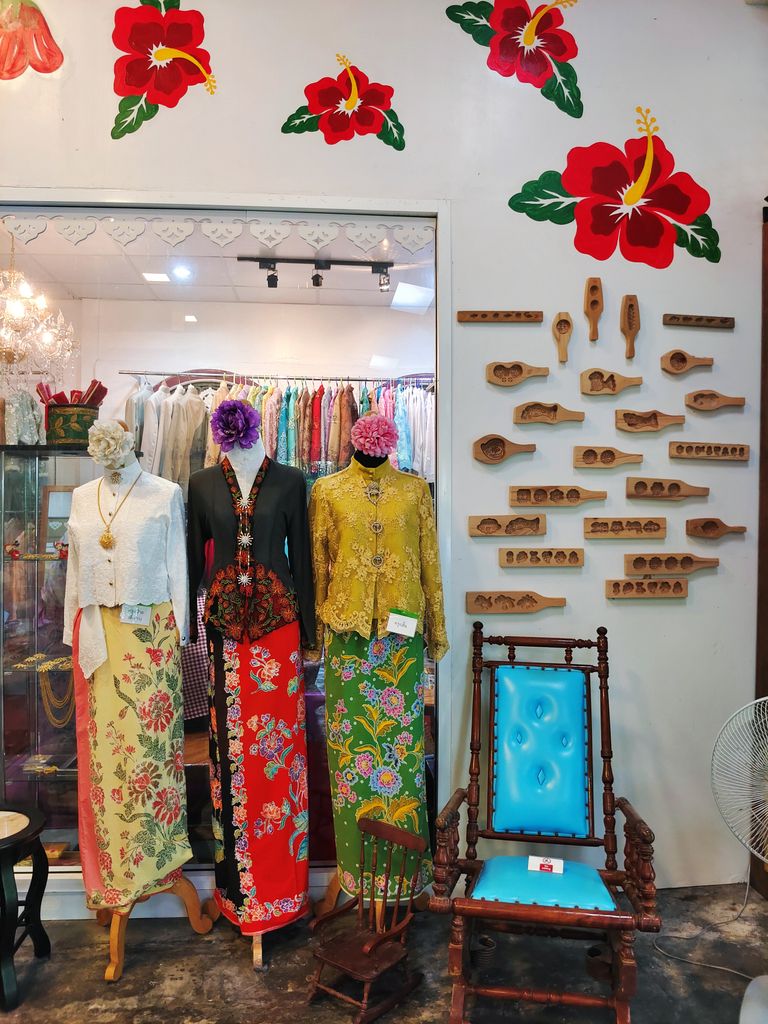
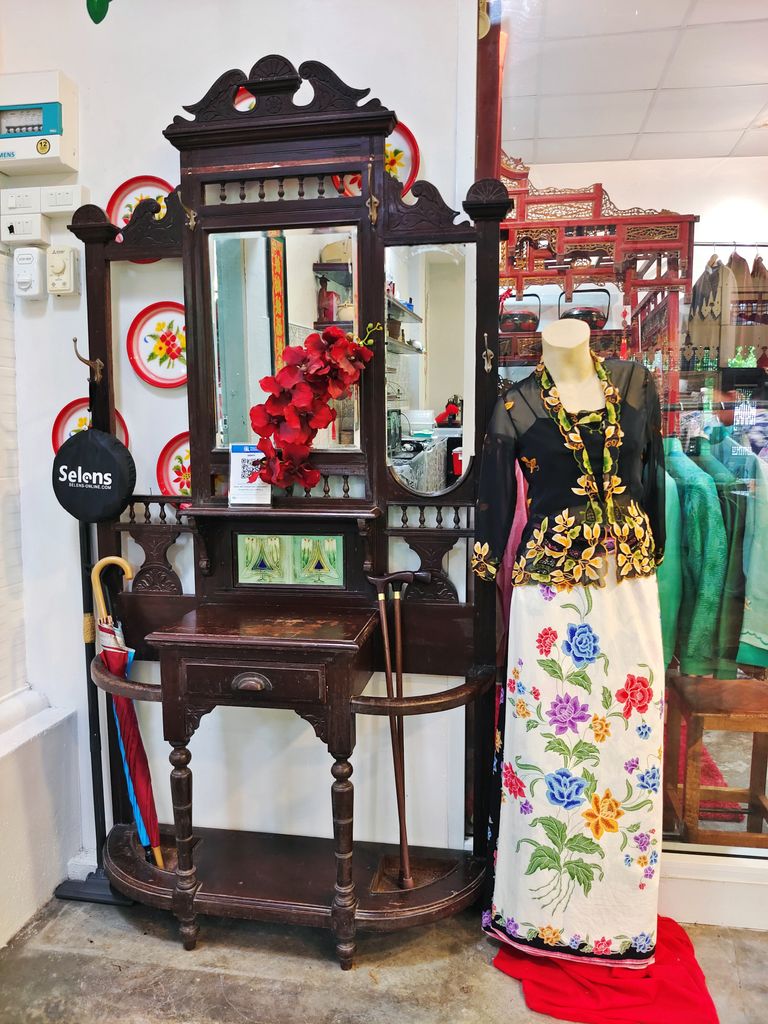
And that brings our delightful journey through Phuket’s history to a close! Exploring Baan Chinpracha was even more enriching than I had imagined, filled with stories, nostalgia, and a deep appreciation for the past. I hope you enjoyed walking through this charming old house with me and got a glimpse of Phuket's unique blend of cultures and heritage.
If you enjoyed this post, don’t forget to reBlurt, follow me for more adventures, and leave a comment to let me know what you think! I’d love to hear your thoughts! 💕
| 📷 Picture | Smartphone |
|---|---|
| Model | Vivo X60 5G |
| Type | Android |
| Photographer | @baiboua |
| Location | Phuket, Thailand |

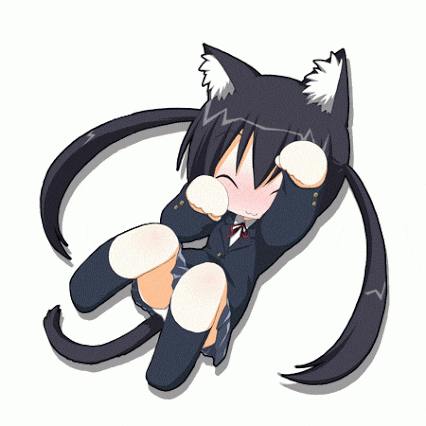
🌸 Thank you for your support 🌸
💖 ขอบคุณสำหรับการโหวต 💖
💕 เลิฟนะยู้ววววววว 💕
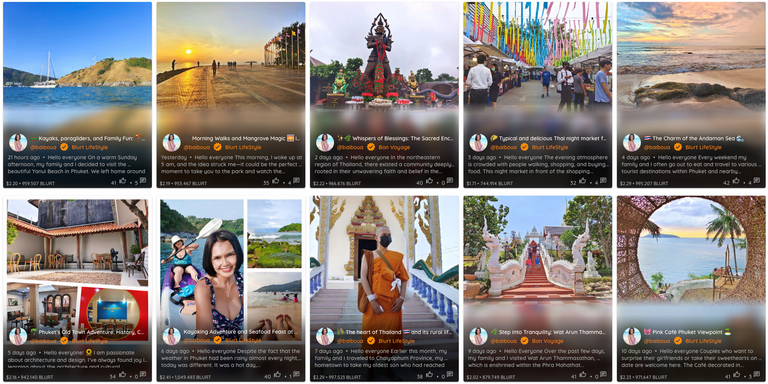
What an interesting place full of culture, and a lovely white dress. Thanks for all the photos!
Yes, it's a surprising place, with much more depth than I anticipated 🌻
Wow! What a nice chance to see this beautiful place! I love to see ancient architecture and to learn about the culture of places with rich history such as the places you mentioned. What a nice post @baiboua! I wish you a good day. :)
Thank you so much! 😊 I'm glad you enjoyed the post. Even I learned new things about Phuket's history that I didn’t know before 🌻
Only love ❤️❤️🫶🫶